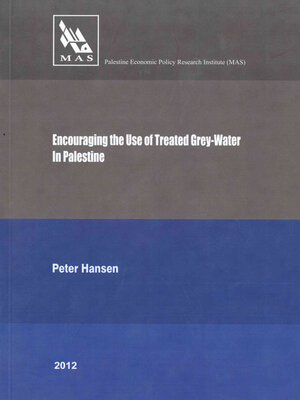
Sign up to save your library
With an OverDrive account, you can save your favorite libraries for at-a-glance information about availability. Find out more about OverDrive accounts.
Find this title in Libby, the library reading app by OverDrive.



Search for a digital library with this title
Title found at these libraries:
| Library Name | Distance |
|---|---|
| Loading... |
In the last twenty years, house onsite wastewater management systems have been increasing in the West Bank’s rural areas. The aim of this research was to reveal, in the context of providing onsite Grey Water Treatment Plants (GWTPs) for wastewater management in the rural communities in Palestine, the local population’s perceptions, in the sense of acceptance of and barriers towards such a type of wastewater management, so as to figure out successes, failures and lessons. The data collection tool was a questionnaire that targeted the households served with GWTPs. The findings show that 13% of the total constructed treatment plants were not operative. The most important barrier as mentioned by 66.5% is odor emission and insect infestation. Then, 25.1% of the implementing agencies never monitor or check the treatment plants, and 59.3% of them monitor and check the plants only during the first 2–3 months. The next barrier is inadequate beneficiary experience in operation and maintenance. Health concerns regarding quality of crops irrigated by treated grey water were another barrier. The results revealed that the reuse of treated grey water in irrigation was the main incentive for GWTPs as stated by 88.0% of beneficiaries. The second incentive was the saving of cesspit discharge frequency and its financial consequences, as stated by 71.3%. Finally, 72.5% of the beneficiaries stated that they had a water shortage before implementing GWTPs, and the GWTPs contributed to solving it. The highest percentage (82.6%) of beneficiaries accepted the treatment units because of their willingness to reuse treated water for irrigation and agricultural purposes. Education level has an impact on GWTP acceptance, with 73% of not educated beneficiaries being satisfied and 58.8% of educated people being satisfied. Islamic religion is considered a driver for accepting reuse of treated grey water in irrigation, according to the majority of people (70%). Women play a major role on GWTP management; 68.9% of the treatment systems are run by men side-by-side with women (fathers and mothers), and 24% are run completely by women. The majority of GWTP beneficiaries (70.4%) are satisfied with GWTPs. Little effort is required for operation and maintenance, with only an average of 0.4 working hours per week. Therefore, house onsite grey water management systems are acceptable in rural communities, but attention should be given to the reasons of acceptance and barriers highlighted in this research.







